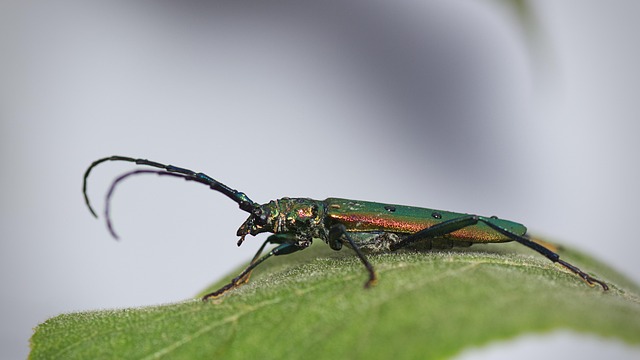Drugstore beetles (Trochilus or Lyperos spp.) are persistent pests that infiltrate retail spaces, particularly those dealing with paper, cardboard, and wood. Prevention involves regular inspections of high-risk areas, sealing entry points, and using suitable storage materials. Customized pest control strategies tailored to these beetles' habits deter infestations by addressing sanitation, hiding spots, and organic waste management. Regular monitoring and cleaning are key to long-term control, maintaining an inhospitable environment for these tiny invaders.
Drugstore beetles (Stegora bilineata) pose a significant challenge in retail environments, damaging products and requiring effective pest control. This article delves into comprehensive strategies to prevent long-term infestations, focusing on tailored plans for drugstore beetle management. We explore their behavior, habitat preferences, and risk assessment techniques. By identifying high-susceptibility areas, implementing targeted prevention measures, and establishing regular monitoring routines, businesses can effectively mitigate these pests’ impact, ensuring a safer and more secure environment.
Understanding Drugstore Beetles: Behavior and Habitat
Drugstore beetles, scientifically known as Trochilus (or Lyperos) sp., are tiny yet tenacious pests that pose a significant challenge to many industries, particularly pharmaceutical and retail stores. Understanding their behavior and habitat is crucial for effective pest control for drugstore beetles. These insects are attracted to a wide range of materials commonly found in stores, including paper products, cardboard, cotton, and even certain types of wood. They are highly adaptable and can thrive in both dry and humid environments, making them hard to eradicate once established.
Drugstore beetles have a unique ability to detect and be drawn to carbon dioxide, which makes them eager visitors to retail spaces. Their tiny size allows them to infiltrate packaging and crevices, leading to infestations that can be difficult to locate and treat. To prevent these pests, regular inspections are essential, focusing on areas where items are stored, displayed, or packaged. Implementing strict hygiene practices, sealing entry points, and using appropriate storage materials can significantly deter drugstore beetles from entering and establishing colonies.
Assessment: Identifying High-Risk Areas for Infestation
Drugstore beetles, known as Trochilidae or Mylis, can infiltrate and wreak havoc in various environments, including retail spaces like drugstores. An effective long-term prevention strategy starts with a meticulous assessment to identify high-risk areas for infestation. By understanding where these pests are most likely to settle, businesses can proactively implement targeted pest control for drugstore beetles.
Key factors to consider during this process include storage areas for merchandise, especially those holding wooden products or materials that attract beetles. Dark, undisturbed corners and spaces behind shelves are prime real estate for these tiny invaders. Regular inspections should also focus on entry points like doors and windows, ensuring seals are tight and any gaps are filled. Identifying and addressing potential breeding grounds is a critical step in preventing an infestation from taking hold and growing.
Implementing Customized Prevention Strategies
Implementing customized prevention strategies is a proactive approach to addressing the specific challenges posed by drugstore beetles in various environments. Unlike one-size-fits-all solutions, tailored plans consider unique factors like facility layout, material storage practices, and previous pest activity. For instance, focusing on implementing robust sanitation protocols in areas prone to beetle infestation can significantly reduce their presence. This involves regular cleaning and removing potential hiding spots or food sources, such as discarded materials or organic waste.
Additionally, integrating physical barriers like sealed containers and insect-proof storage units is essential for effective pest control for drugstore beetles. These measures prevent access to products and limit the beetles’ ability to breed and spread. Customized plans also benefit from monitoring systems that detect early signs of infestation, enabling swift action to contain and eliminate these pests before they cause widespread damage.
Regular Monitoring and Maintenance Procedures
Regular monitoring is a key component in any effective long-term pest control for drugstore beetles strategy. This involves setting up a structured inspection schedule to identify potential beetle infestations at an early stage. By conducting routine checks, you can promptly address any signs of activity, preventing the issue from escalating. During these inspections, it’s essential to pay close attention to hidden areas such as crevices, seams, and packaging materials where drugstore beetles tend to hide. Trained personnel should use specialized tools and techniques to ensure thoroughness.
Maintaining a clean and organized environment is another critical aspect of beetle prevention. Regular cleaning routines should be implemented to remove any debris or organic matter that could attract the pests. This includes sanitizing surfaces, vacuuming floors, and properly disposing of waste. Additionally, keeping inventory well-organized and sealed can minimize access points for beetles. Consistent maintenance procedures, combined with regular monitoring, create an inhospitable environment for drugstore beetles, significantly reducing the risk of infestations.
Drugstore beetle prevention requires a multi-faceted approach. By understanding these pests’ behavior, identifying high-risk areas through assessment, and implementing customized strategies tailored to specific needs, businesses can effectively deter infestations. Regular monitoring and maintenance are key to catching any early signs of an issue. With the right combination of knowledge, proactive measures, and consistent care, it’s possible to maintain a beetle-free environment, ensuring customer safety and preserving products. Effective pest control for drugstore beetles starts with these comprehensive, long-term prevention plans.
